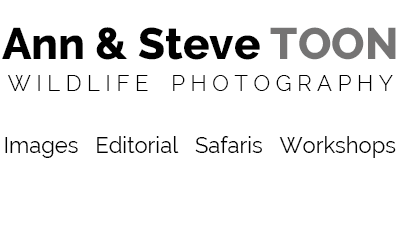An Australian photo mag recently described us as ‘veteran wildlife photographers’. Now it’s true we started out in the good old, bad old days of Fuji Velvia and the nearest we got to digital media was finger painting. But hey, we’ve still got our own teeth and hair. Mostly.

You want to be a WHAT!?
We’ll take it as a compliment. But older and wiser? I’m not so sure. It still feels like every day brings something new and challenging to learn about the mysterious art and science of photographing wildlife. That’s part of the addiction.
Fourteen years or so of doing the job as so-called ‘professionals’ doesn’t feel like very long. We can still vividly remember listening in thrall to a couple of established pros we met on an early visit to the Kalahari, as we picked their brains about their photo adventures in Africa. If they can do it, why can’t we? Such was our naïve thinking. Perhaps if we’d known the reality then, we might have taken a more sensible course. But sometimes it’s good to be naïve, and we’ve certainly no regrets.
We’ve come a long way since then: these days hopefuls contact us seeking advice on starting out. It’s always a tricky business trying to strike a balance between constructive encouragement and honest realism. So what do we say?
1. Find a rich partner, win the lottery, or inherit a private fortune.

Excuse me, can you tell me the way to the Mara?
You’ll never get rich photographing wildlife. Even if you snap a shot of the Loch Ness monster, you’ll find yourself sharing the license fees with an agent who takes 60 per cent, negotiating with picture editors who tell you they can get a better shot for next to nothing on microstock, and fending off a horde of NGOs, charities, government agencies and publishers with no budget for photography who want to use your image for free, in return for a credit. Everybody loves a good picture, but no-one wants to pay for one.
2. Picture credits are your right, not a privilege. Oh, and they are also worthless.

Close encounters: the job is its own reward. Yeah right.
If you want to give away your images for nothing (thereby undermining the livelihood of your fellow professionals, perpetuating the devaluation of quality imagery and driving the world toward Armageddon) that’s your prerogative. But don’t do it because someone promises you ‘a credit’. If someone uses your work they should credit you as a matter of course. They’re not doing you a favour. And in any case, the idea that having your name in 7pt below an image is going to send picture buyers flocking to your website is a myth. We can count on one hand the number of images we’ve sold as a result of someone seeing a credit.
3. Be professional. But don’t expect other people to be.

The day we got paid on time.
As a freelance photographer, you’re at the very bottom of the publishing pecking order. To stand any chance of making a living, you need to develop regular clients, and to do that you need to be totally reliable, delivering technically excellent, tightly edited images every time, and always on time. Don’t ever promise what you can’t deliver. In return, expect clients to be nice as pie when they want something doing urgently, but to completely ignore your emails and phone calls when they don’t need anything, to routinely reschedule publication of your work without a word of warning, to reuse your work on digital media without permission or payment, and to forget to pay you agreed fees until months after they were due. Suck it up, you’re freelance.
4. Save the planet

Photographing at the sharp end
These days it’s not enough to take pretty pictures of wildlife and wild places. Every wildlife photographer worth their salt has to be a ‘conservation photographer’. Sorry, it’s the law. But don’t worry, it needn’t be too onerous. Just rescue a couple of duff shots from the recycle bin, send them to an obscure conservation NGO as a free gift, and Hey Presto! you’re a conservation photographer. Wasn’t so difficult, was it? And didn’t cost you a penny. Of course, you could always do it properly, following the example of true conservation photographers, investing time and money (your own, naturally) on documenting worthwhile stories, supporting good causes, and raising awareness of the realities of the natural world. Just don’t expect any thanks.
5. Give duff advice

An expert at work.
Once you’ve had a couple of shots published, you can call yourself a pro – why not, everybody else does? Then you too can look forward to people contacting you asking for advice on starting out. Remember, it’s a dog-eat-dog competitive world out there, too many photographers chasing too few opportunities, and you don’t need any more competition. So make sure any advice you give looks good, but is essentially worthless.
6. Ignore duff advice

Listen politely – then ignore
Remember, it’s a dog-eat-dog competitive world out there, too many photographers chasing too few opportunities, and they don’t need any more competition. So when cynical, self-serving old-timers tell you the way of the world, nod politely and ignore them. Photographing wildlife may be a crazy career choice, but it’s also a fantastic way of life and if you want it badly enough you’ll make it happen. It sure beats working for a living.

